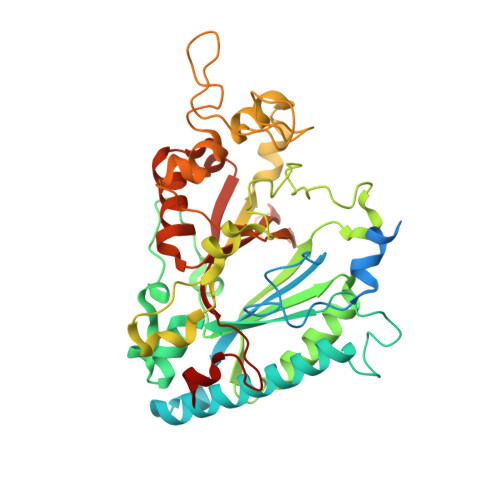Dye-decolorizing peroxidase of Thermobifida halotolerance displays complex kinetics with both substrate inhibition and apparent positive cooperativity.
Pupart, H., Lukk, T., Valjamae, P.(2024) Arch Biochem Biophys 754: 109931-109931
- PubMed: 38382807
- DOI: https://doi.org/10.1016/j.abb.2024.109931
- Primary Citation of Related Structures:
8CK9 - PubMed Abstract:
Dye-decolorizing peroxidases (DyPs) have been intensively investigated for the purpose of industrial dye decolourization and lignin degradation. Unfortunately, the characterization of these peroxidases is hampered by their non-Michaelis-Menten kinetics, exemplified by substrate inhibition and/or positive cooperativity. Although often observed, the underlying mechanisms behind the unusual kinetics of DyPs are poorly understood. Here we studied the kinetics of the oxidation of 2,2'-azino-bis(3-ethylbenzothiazoline-6-sulfonic acid) (ABTS), hydroquinones, and anthraquinone dyes by DyP from the bacterium Thermobifida halotolerans (ThDyP) and solved its crystal structure. We also provide rate equations for different kinetic mechanisms explaining the complex kinetics of heme peroxidases. Kinetic studies along with the analysis of the structure of ThDyP suggest that the substrate inhibition is caused by the non-productive binding of ABTS to the enzyme resting state. Strong irreversible inactivation of ThDyP by H 2 O 2 in the absence of ABTS suggests that the substrate inhibition by H 2 O 2 may be caused by the non-productive binding of H 2 O 2 to compound I. Positive cooperativity was observed only with the oxidation of ABTS but not with the two electron-donating substrates. Although the conventional mechanism of cooperativity cannot be excluded, we propose that the oxidation of ABTS assumes the simultaneous binding of two ABTS molecules to reduce compound I to the enzyme resting state, and this causes the apparent positive cooperativity.
- Department of Chemistry and Biotechnology, Tallinn University of Technology, Akadeemia tee 15, 12618, Tallinn, Estonia. Electronic address: hegne.pupart@taltech.ee.
Organizational Affiliation:


















